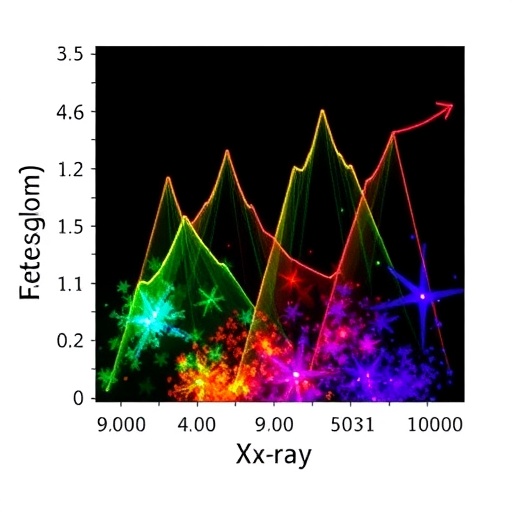Understanding the intricate dynamics of redox properties and catalytic behavior in proteins is paramount for leveraging their functionalities in biocatalysis. This foundational comprehension is equally essential for advancing the design of efficient bio-inspired catalysts which can significantly contribute to the fields of renewable energy and sustainable chemistry. Traditional methods for characterizing these properties often fall short in providing the comprehensive insights needed to fully harness these biological catalysts. However, a multifaceted innovative approach known as enzymatic X-ray absorption spectroelectrochemistry (XA-SEC) is emerging as a transformative solution.
XA-SEC melds the probing capabilities of X-ray absorption spectroscopy with the precision and control offered by electrochemical techniques. This fusion enables researchers to reveal the complex oxidative and reductive transformations that enzymes undergo during catalysis. The result is a deeper understanding of how enzymes interact with substrates, how they facilitate reactions, and how their redox states influence activity. Additionally, such insights can significantly accelerate the design of biomimetic catalysts, a crucial step towards sustainable chemical processes.
The execution of enzymatic XA-SEC experiments necessitates meticulous preparation and execution to capture the fine details of enzyme behavior. Initially, the procedure involves preparing a carbon-based working electrode, a critical component that aids in enzyme immobilization. The choice of a carbon substrate is not arbitrary; it facilitates robust interactions with the enzyme, significantly enhancing its loading capacity and improving electron transfer efficiency. Among various enzymes, bilirubin oxidase from Myrothecium verrucaria serves as an exemplary candidate due to its favorable redox properties and catalytic efficiency.
Preliminary phases of the XA-SEC experiment focus on the effective immobilization of the enzyme on the electrode surface, often enhanced by incorporating nanomaterials. These materials not only elevate the mechanical stability of enzyme binding but also optimize the conduction pathways for electron transfer at the enzyme-electrode interface. This innovation is crucial for ensuring that the enzyme remains active and in close proximity to the electrode during the entire spectroscopic analysis.
Following the preparation of the working electrode, researchers set up a standard three-electrode electrochemical cell. The configuration of the cell is key to maintaining stable and reliable measurements, and ensuring proper electrical connections plays a vital role in the reproducibility of results. The electrode system typically consists of a reference electrode to maintain a constant potential and a counter electrode to complete the circuit, thus facilitating a controlled environment for the enzymatic reactions to occur.
Electrolyte preparation is another crucial step in the protocol. The choice of electrolyte must support the solubility of substrates and provide conducive ionic conditions for electron transfer. A well-optimized electrolyte leads to enhanced enzyme activity and stability, which are vital for obtaining accurate spectroscopic data. Researchers must consider factors such as ionic strength, pH, and potential redox-active components within the electrolyte to create an ideal environment for enzymatic activity.
Once the electrochemical cell is established, researchers can dive into the X-ray absorption spectroscopy measurement procedure. Utilizing synchrotron light sources, high-intensity beams facilitate the analysis of the Cu K-edge X-ray absorption, which is indispensable for elucidating the electronic states of the metal centers within the enzyme. During this measurement, applying in situ electrochemical control allows real-time monitoring of the enzyme’s redox processes as they unfold.
Real-time monitoring provides a wealth of thermodynamic and kinetic information about the enzymatic reactions under study. By employing direct electron transfer analysis, researchers can observe how efficiently electrons are exchanged between the enzyme and the electrode, ultimately shedding light on the energetic landscape of the catalytic process. Such detailed insights into the electron transfer pathway are crucial in understanding the efficiency of the enzyme and identifying potential bottlenecks within the reaction mechanism.
Moreover, it is paramount to gauge the stability and activity of the enzyme during X-ray exposure. The spectroscopic signals must remain stable over extended experimental intervals; otherwise, the observations might be compromised. Typically, the proven methodology of XA-SEC leads to long-lasting and stable electrochemical and spectroscopic signals. This endurance showcases not only the robustness of the enzyme during experimental conditions but also the efficacy of protein immobilization techniques employed.
The capacity to correlate XA-SEC measurements with direct electron transfer data establishes a potent analytical framework that advances the understanding of enzymatic electrocatalysis. It allows researchers to not just observe, but to quantitatively assess how substrates bind to enzymes and how changes in redox states affect catalytic outcomes. This rich dataset can elucidate broader principles governing enzyme functionality, and thereby inform the development of next-generation bioelectrochemical technologies.
As research into XA-SEC continues to evolve, its applications extend beyond fundamental enzymatic studies. Insights gained from this approach can drive developments in sustainable chemical processes, such as the efficient conversion of renewable resources into valuable chemical products. In a world increasingly driven by the quest for sustainability, harnessing biocatalysts for industrial applications could pave the way for a new era of green chemistry.
This innovative technique positions scientists at the forefront of enzyme research, empowering them to not just understand, but also to manipulate enzymatic processes for enhanced industrial utility. The increasing integration of advanced materials and electrochemical techniques indicates a promising trajectory for enzymatic studies, where bioinspired catalysts could soon rival traditional metallic counterparts in various applications, from energy generation to pollution reduction.
In conclusion, enzymatic X-ray absorption spectroelectrochemistry represents a holistic approach to studying enzyme redox properties and catalytic behavior. The methodologies outlined in this emerging field are crucial for both academic research and practical applications. By bridging gaps in understanding how enzymes operate at the molecular level, this technique is expected to facilitate breakthroughs in the development of sustainable bioprocesses that are less reliant on non-renewable resources.
The implications of XA-SEC are profound and potentially transformative. The capacity to observe and manipulate the electron flow in real-time, alongside the accompanying structural data obtained through X-ray absorption spectroscopy, sets the stage for a new paradigm in enzyme research. As the protocols continue to be refined and expanded, the broader impact of this work on biotechnology and environmental sustainability cannot be overstated.
Through rigorous experimentation and collaborative efforts across scientific disciplines, the goal of creating efficient, bio-inspired catalysts appears increasingly achievable. Enzymatic electrocatalysis presents an inviting frontier, with the potential to unlock new sustainable pathways for chemical synthesis. As we delve deeper into the world of enzyme catalysis, techniques like XA-SEC will undoubtedly be paramount in guiding future advancements and innovations.
Subject of Research: Enzymatic X-ray absorption spectroelectrochemistry for elucidating redox properties and catalytic behavior of enzymes.
Article Title: Enzymatic X-ray absorption spectroelectrochemistry.
Article References:
Colombo, R.N.P., Sedenho, G.C., Neckel, I.T. et al. Enzymatic X-ray absorption spectroelectrochemistry.
Nat Protoc (2025). https://doi.org/10.1038/s41596-025-01254-5
Image Credits: AI Generated
DOI:
Keywords: Enzymatic X-ray absorption spectroelectrochemistry, redox properties, catalytic behavior, biocatalysis, sustainable chemistry.
Tags: bio-inspired catalysts for sustainable chemistrybiocatalysis in renewable energybiomimetic catalyst designcatalytic behavior of enzymeselectrochemical techniques in researchenzymatic spectroelectrochemistry techniquesenzyme immobilization strategiesenzyme-powered X-ray absorption spectroscopyenzyme-substrate interactionsredox properties of proteinstransformative approaches in spectroelectrochemistryXA-SEC experimental methodology





